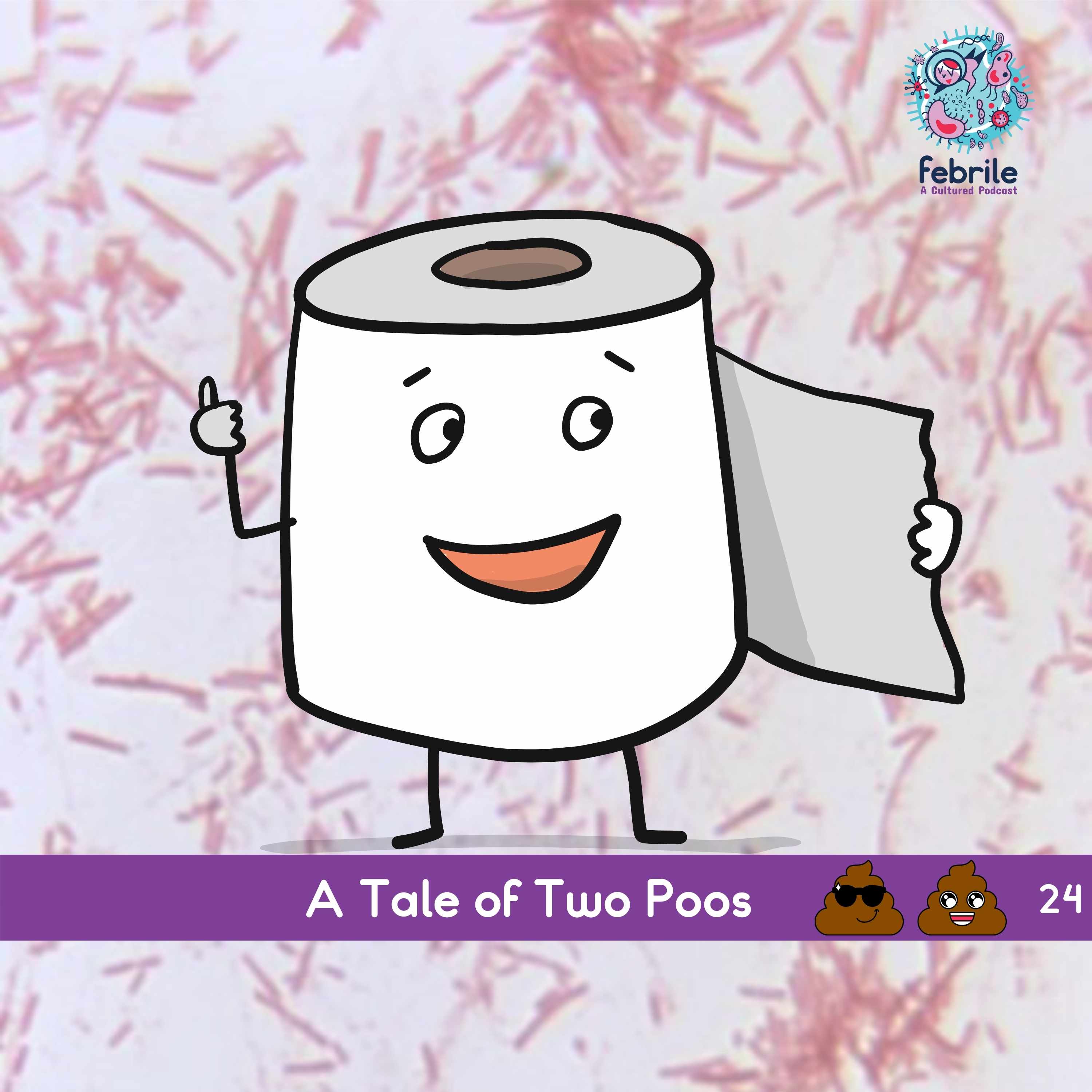Credits
Hosts: Evelyn Wu, Sara Dong
Guest: Lucy Marquez
Writing: Evelyn Wu, Sara Dong
Producing/Editing/Cover Art/Infographics: Sara Dong
Our Guests
Lucy Marquez, MD, MPH

Dr. Lucy Marquez graduated from Baylor College of Medicine (BCM), and she remained at BCM to complete a residency in Pediatrics, a Chief Resident Year, and a fellowship in Pediatric Infectious Diseases. She additionally graduated from the University of Texas School of Public Health with an MPH focusing in epidemiology. She is currently an attending physician in pediatric infectious diseases at BCM, and practices primarily at the Medical Center Campus of Texas Children’s Hospital. Dr. Marquez cares for children with a range of infectious diseases both in the inpatient and outpatient setting. Additionally, she is the Associate Medical Director for Infection Control and Prevention at Texas Children’s Hospital. She is also passionate about medical education and teaches a variety of learners including medical students, residents and fellows at Baylor College of Medicine and Texas Children’s Hospital.
Evelyn Wu

Evelyn is a medical student at Rutgers Robert Wood Johnson Medical School
Culture
Lucy talked about her love for all things dulce du leche!
Consult Notes
Consult Q
Assistance with management of diarrhea in a child
One-liners
- 6 year old previously healthy boy with fever and bloody diarrhea who was found to have E.coli O157:H7 infection and hemolytic uremic syndrome
- 9 month old full term previously healthy female with diarrhea and seizures who was diagnosed shigellosis
Key Points
Jump to:
Approaching diarrhea
- There are a wide variety of possible causes of diarrhea in a child. What are some possible pivot points as you gather information?
- Acute onset vs chronic?
- Is the child acutely ill?
- Bloody or nonbloody diarrhea?
- Immunocompromised or not?
- Have you seen the IDSA Clinical Practice Guidelines for Infectious Diarrhea? Shane AL, Mody RK, Crump JA, et al. 2017 Infectious Diseases Society of America Clinical Practice Guidelines for the Diagnosis and Management of Infectious Diarrhea. Clin Infect Dis. 2017;65(12):e45-e80. doi:10.1093/cid/cix669
E.coli is a common bacterial cause of diarrheal illness. Here’s a brief overview of the various types of diarrhea-producing E.coli strains but we will ultimately focus on STEC
- There are at least 5 classic pathotypes of diarrhea-producing E.coli strains, distinguished by genetic/pathogenic/clinical characteristics
- Strains and lineages classified by O (somatic/part of LPS) and H antigens (flagellar)
- You can find more details about these 5 types in the table infographic, but will include a little more information about the shiga-toxin producing E.coli (STEC) here as well
- STEC O157:H7 is the serotype most often implicated in outbreaks and is consistently a virulent STEC serotype (although others can also cause illness)
- Usually starts with nonbloody diarrhea → changes to bloody after 2-3 days (representing onset of hemorrhagic colitis)
- Severe abdominal pain is generally short-lived
- Fever in about a third of cases
- Consider STEC organisms in those with intussusception, appendicitis, IBD, or ischemic colitis
- There are two types of Shiga toxin: Stx1 and Stx2 (there are a few variants of each type)
- Generally STEC strains that produce Stx2 are more virulent than those than only produce Stx1 (however in the clinical setting, there is limited ability to differentiate between Stx variants)
- Check out the AAP Red Book: Section 3: Summaries of Infectious Diseases > Escherichia coli Diarrhea (Including Hemolytic Uremic Syndrome)
- Table 3.7: Classification of E.coli associated with diarrhea
- A review of Shiga-toxin producing E.coli and HUS: Tarr PI, Gordon CA, Chandler WL. Shiga-toxin-producing Escherichia coli and haemolytic uraemic syndrome. Lancet. 2005;365(9464):1073-1086. doi:10.1016/S0140-6736(05)71144-2
What are the sequelae of STEC infection?
- Hemolytic uremic syndrome (HUS) is a serious complication, commonly associated with STEC O157:H7
- Defined by microangiopathic hemolytic anemia, thrombocytopenia, acute renal dysfunction
- Occurs in ~15% of children younger than 5 years with lab-confirmed E.coli O157 infection (compared to ~6% among people of all ages) and in ~1% of patients of all ages with lab-confirmed non-O157 STEC infection
- Typically develops 1-2 weeks after onset of diarrhea
- Risk of developing HUS is lower in children with longer interval between diarrhea onset and presentation to ED
- >50% of children with HUS require dialysis; 3-5% die; Patients can also develop neurologic complications
- Most patients who survive have a very good prognosis
- Intussusception can very rarely occur
Diagnostics for STEC/E.coli O157:H7
- When STEC is suspected → rectal swab or stool should be sent for selective culture for E.coli O157:H7 and Shiga toxin testing, either by immunoassay following overnight broth culture or by molecular technology
- Selective culture for STEC: sorbitol-MacConkey (SMAC) agar is typical selective media for E.coli O157:H7
- This serotype ferments sorbitol slowly and appears as translucent colonies
- Remember that bacteria are only present in stools for a few days, so may not be detected later in course (such as when HUS symptoms may be present)
- Shiga toxin testing: Several commercially available sensitive, specific, and rapid assays are available for Shiga toxins in stool or brother culture of stool
- Enzyme immunoassay (EIA) following incubation in broth culture can detect E.coli O157:H7 as well as non-O157 STEC, but can fail to detect 10-15% of E.coli O157 detected on agar plating
- Immunochromatographic assays
- Molecular testing
- Multiplex PCR assays / molecular panels can detect a variety of enteric pathogens, and typically include nucleic acid amplification tests that detect genes for Shiga toxins 1 and 2
- Caveats:
- Make sure specimens submitted for culture if Shiga toxin gene identified by NAAT!
- Pathogen isolation is critically important for epidemiologic analysis and outbreak tracing
- Although many tests can distinguish between Shiga toxins 1 and 2, these details are not necessarily reported
- In settings other than acute diarrhea, the clinical relevance of positive STEC NAAT is unclear
- Diagnostics may detect multiple pathogens (multiple enteric infections are more likely in patients with non-O157 STEC, however some non-O157 E.coli can possess gene for Shiga toxin 2)
- Make sure specimens submitted for culture if Shiga toxin gene identified by NAAT!
Management of STEC (and in setting of HUS)
- Fluid hydration is cornerstone!!
- May be particularly protective against development of nephropathy associated with HUS
- The impact of antibiotic therapy with STEC infections remains controversial because of the concern for association of increased risk of developing HUS in some studies
- It’s uncertain whether giving antibiotics during the bloody diarrheal phase may be dependent on infecting STEC genotype and/or choice of antibiotic
- A meta-analysis did not find that children with hemorrhagic colitis caused by STEC had greater risk of developing HUS if treated. However, an association was found in analyses restricted to studies with low risk of bias and using accepted HUS definition — so the strength of association between antibiotic use and HUS might depend on case definition of HUS used
- Noted above: Freedman SB, Xie J, Neufeld MS, et al. Shiga Toxin-Producing Escherichia coli Infection, Antibiotics, and Risk of Developing Hemolytic Uremic Syndrome: A Meta-analysis. Clin Infect Dis. 2016;62(10):1251-1258. doi:10.1093/cid/ciw099
- Tarr GAM, Oltean HN, Phipps AI, Rabinowitz P, Tarr PI. Strength of the association between antibiotic use and hemolytic uremic syndrome following Escherichia coli O157:H7 infection varies with case definition. Int J Med Microbiol. 2018;308(7):921-926. doi:10.1016/j.ijmm.2018.06.009
- Wong CS, Jelacic S, Habeeb RL, Watkins SL, Tarr PI. The risk of the hemolytic-uremic syndrome after antibiotic treatment of Escherichia coli O157:H7 infections. N Engl J Med. 2000;342(26):1930-1936. doi:10.1056/NEJM200006293422601
- There has not been a controlled trial, so beneficial effect of abxs has not been proven and remains unclear
- Most recently published observational studies found that treatment with at least some antimicrobial agents was associated with HUS
- Most experts advise not prescribing antimicrobial therapy for children with E.coli O157 enteritis or clinical/epi picture strongly suggestive of STEC
What are the key points to remember about epidemiology and infection control for STEC infections?
- Epidemiology
- STEC is shed in feces of cattle as well as a few other animals (such as sheep, deer) → transmission is due to contamination with human or animal feces or from infected symptomatic people
- Acquired via:
- contaminated food or water, or
- contact with infected person, fomite, carrier animal, or its environment
- Many foods have caused outbreaks, including raw leafy vegetables, undercooked ground beef, unpasteurized milk and juice products
- Outbreak investigations have previously implicated petting zoos, water sources, ingestion of recreational water
- Infectious dose is low! So person-to-person transmission is common in households and child care centers
- Incubation period for:
- Most diarrhea-associated E.coli strains = 10h to 6d
- E.coli O157 = usually 3-4 d
- Infection Control/Prevention
- All meat should be cooked thoroughly. Ground beef until no pink meat and juices clear and temp 160F
- Avoid raw milk or unpasteurized apple/cider products
- Avoid ingesting recreational water. Showering before swimming, taking children to restroom frequently, changing diapers at designated stations, and then washing hands can limit transmission of pathogens through recreational water
- Take care to prevent cross-contamination in food preparation
- Hand washing after contact with raw/undercooked meats, animals, environments around animals, animal food or treats
- Ill children with STEC O157 infection or virulent non-O157 STEC infection should be excluded from child care until:
- 2 stool cultures (obtained at least 48 hrs after any antibiotics, if given, have been discontinued) are negative
- Stools are contained in diaper or child is continent
- Stool frequency is no more than 2 stools above child’s normal frequency
- Local or state public health department regulations met (some have less stringent exclusion policies for those who recover from less virulent STEC infection)
- Passive surveillance data is collected through CDC. You can also look at the CDC website to see recent outbreaks
Next in case two, we covered Shigella infections!
- Microbiology:
- Facultative aerobic, gram negative bacilli
- S.sonnei is most common in US. Other spp include: S.flexneri, S.dysenteriae, S.boydii. There are more than 40 serotypes amongst the four species.
- Shiga toxin produced by S.dysenteriae serotype 1 enhances the virulence and can cause small blood vessel and renal damage, leading to HUS in some
- Clinical presentations range from watery stools with minimal or no constitutional symptoms to more severe (high fever, abdominal cramps, tenesmus, mucoid stools +/- blood)
- Primarily infects the large intestine
- Shigella dysenteriae serotype 1 often causes more severe illness than other spp with high risk of complications (septicemia, pseudomembranous colitis, toxic megacolon, intestinal perforation, hemolysis, HUS) >> but this is rare in industrialized countries
- Like in the podcast case, generalized seizures have been attributed to any serotype
- Typically self-limited
- Usually associated with high fever and electrolyte abnormalities
- Khan WA, Dhar U, Salam MA, Griffiths JK, Rand W, Bennish ML. Central nervous system manifestations of childhood shigellosis: prevalence, risk factors, and outcome. Pediatrics. 1999;103(2):E18. doi:10.1542/peds.103.2.e18
- Septicemia: More often in neonates, but can occur in other children
- Reactive arthritis with possible extra-articular manifestations are rare complications that can occur weeks or months later, especially in patients expressing HLA-B27
- Post-infectious IBS can occur and last weeks to months
Diagnostic testing
Isolation in culture of Shigella from feces or rectal swab specimens containing feces is diagnostic
- Sensitivity is improved by testing asap after stool is passed and use of enrichment broth media and selective agar plate media → fastidious organism
- Best yield is from mucoid part of stool
- Hektoen enteric agar is used for Shigella and Salmonella
- Selective for GN enterics with higher bile salt concentrations than MacConkey
- Contains pH indicator dye, which goes from green to yellow/orange if any lactose/sucrose are fermented → any yellow/orange colonies are NOT Salmonella or Shigella as neither ferments any of these | Shigella is lactose non-fermenter
- Contains sodium thiosulfate so organisms can produce H2S → ferric ammonium citrate reacts with H2S gas to form black precipitate → Shigella will be green colony vs. Salmonella with green colony and black center due to H2S production
- Molecular testing
- Multiplex PCR platforms have high sensitivity, but PCR will not distinguish between viable and nonviable organisms.
- As Lucy noted, this also will not allow you to determine susceptibility testing → To guide treatment if needed and to enable surveillance and outbreak detection, stool cultures are recommended
Management of Shigella infections
- Like with other diarrheal illnesses, correction of dehydration and electrolyte losses is mainstay!!
- Most clinical infections with S.sonnei are self-limited (48-72 hrs) and mild → do not require antibiotic therapy
- Antimicrobial treatment is recommended for patients with: severe disease or underlying immunocompromising conditions
- Available evidence suggests that antibiotics can shorten duration of diarrhea and hasten eradication of organisms from feces
- It’s not clear whether antibiotics prevent relapse though
- Christopher PR, David KV, John SM, Sankarapandian V. Antibiotic therapy for Shigella dysentery. Cochrane Database Syst Rev. 2010;2010(8):CD006784. Published 2010 Aug 4. doi:10.1002/14651858.CD006784.pub4
- Susceptibility testing of clinical isolates is indicated to guide therapy because of common and increasing resistance. In 2018, 70% of isolates were resistant to >=3 classes
- In the US, ~15% of Shigella isolates were resistant to ciprofloxacin and ~34% had decreased susceptibility to azithromycin. Ceftriaxone resistance has also been reported but is still relatively uncommon in the US. [Take a look at NARMS Now data from CDC here]
- First-line therapy options:
- Azithromycin x 3 days
- Clinical labs often unable to perform azithro susceptibilities because clinical breakpoints not established
- Fluoroquinolone x 3 days
- Avoid if strain MIC >=0.12 for ciprofloxacin even if lab report is “S”
- Ceftriaxone x 2-5 days
- Oral cephalosporins have unclear efficacy
- Azithromycin x 3 days
- Alternative options: oral ampicillin or TMP-SMX x 5d (amoxicillin not effective given rapid absorption from GI tract)
What are the key points to remember about epidemiology and infection control for Shigella infections?
- Epidemiology
- Humans are the natural host
- Fecal-oral route for transmission typically but can also occur with contaminated objects, ingestion of contaminated food/water, sexual contact, ?houseflies/roaches as vectors?
- Ingestion of as few as 10 organisms, depending on spp, is sufficient to cause infection
- Can survive for prolonged time in water and food
- Increased risk of infection: children under 4 in child care settings; people in crowded conditions; MSM
- Even without antibiotics, carrier state usually ceases within 1-4 wks after onset of illness; long-term carriage is uncommon
- Incubation period ranges from 1-7d but typically 1-3d
- Infection Control
- Meticulous hand hygiene is most important
- Use of safe drinking water, chlorination of water sources, refrigeration and proper cooking of food
- Eliminating access to shared water-play areas and contaminated diapers can decrease infection rates
- Children with shigellosis should be excluded from child care until:
- State or local public health department regulations met
- Stools contained in diaper or child is continent
- Stool frequency no more than 2 stools above baseline, even if remain loose
We also ended with discussion of antimotility or antidiarrheal agents.
- As Lucy said, “just say no” to antidiarrheals in children with inflammatory or bloody diarrhea
- These antidiarrheal compounds (that inhibit intestinal peristalsis) are contraindicated because they can:
- Prolong the clinical and bacteriologic course of disease
- Increase rate of complications such as complicated HUS
- Bell BP, Griffin PM, Lozano P, Christie DL, Kobayashi JM, Tarr PI. Predictors of hemolytic uremic syndrome in children during a large outbreak of Escherichia coli O157:H7 infections. Pediatrics. 1997;100(1):E12. doi:10.1542/peds.100.1.e12
- Cimolai N, Carter JE, Morrison BJ, Anderson JD. Risk factors for the progression of Escherichia coli O157:H7 enteritis to hemolytic-uremic syndrome [published correction appears in J Pediatr 1990 Jun;116(6):1008]. J Pediatr. 1990;116(4):589-592. doi:10.1016/s0022-3476(05)81609-9
- Cimolai N, Morrison BJ, Carter JE. Risk factors for the central nervous system manifestations of gastroenteritis-associated hemolytic-uremic syndrome. Pediatrics. 1992;90(4):616-621.
We also made note of counseling on return to child care settings. I added the disease specific recommendations in the section above, but check out and bookmark these AAP Red Book Tables for future reference:
- Table 2.2 covers general recommendations for exclusion of children from group child care and school
- Table 2.3 covers disease or condition specific recommendations for exclusion of children from group child care
- (both in Section 2: Recommendations for Care of Children in Special Circumstances > Children in Group Child Care and Schools)
Other miscellaneous mentions and notes:
- Like textbook references?
- AAP Red Book sections as noted above
- Long, Principles and Practice of Pediatric ID, 5th Ed.: Chapter 137 E.coli, Chapter 147 Shigella Species
- Comprehensive Review of Infectious Diseases
Episode Art & Infographics
Goal
Listeners will be able to understand key clinical features and management in acute diarrheal illness in children due to E.coli and Shigella.
Learning Objectives
After listening to this episode, listeners will be able to:
- Identify the classic pathotypes of diarrhea-producing E.coli strains, in particular Shiga toxin-producing E.coli (STEC)
- Describe hemolytic uremic syndrome as complication of STEC infection and risks/benefits of antibiotic administration in this setting
- Identify neurologic manifestations as a complication of childhood shigellosis
- Recognize increasing resistance patterns of Shigella in US
Disclosures
Our guest (Lucy Marquez) as well as Febrile podcast and hosts report no relevant financial disclosures
Citation
Marquez, L., Wu, E., Dong, S. “#24: A Tale of Two Poos”. Febrile: A Cultured Podcast. https://player.captivate.fm/episode/f22ab6d5-73f4-472d-b4ad-018031bc3435


